
94% of researchers rate our articles as excellent or good
Learn more about the work of our research integrity team to safeguard the quality of each article we publish.
Find out more
ORIGINAL RESEARCH article
Front. Plant Sci., 29 April 2024
Sec. Plant Nutrition
Volume 15 - 2024 | https://doi.org/10.3389/fpls.2024.1354384
This article is part of the Research TopicAdaptive Nutrient Management Systems for Plant Nutrition: Optimization, Profitability, and Ecosystem AssessmentView all 15 articles
 Manman Yuan1
Manman Yuan1 Gang Wu1
Gang Wu1 Jiabao Wang1
Jiabao Wang1 Chuang Liu1
Chuang Liu1 Yegong Hu2
Yegong Hu2 Run Hu3
Run Hu3 Yan Zhou4
Yan Zhou4 Xiangming Zhang1
Xiangming Zhang1 Wenjun Wang1
Wenjun Wang1 Yixiang Sun1*
Yixiang Sun1*One-time application of blended controlled-release nitrogen fertilizer (CRN) has the potential to solve the difficulty of top-dressing fertilizer in the cultivation of rice and reduce the cost of CRN fertilizer application. However, its effects on rice dry matter and nitrogen (N) accumulation and translocation, yield and N-use efficiency (NUE) remain uncertain. Field experiments were carried out at three sites (Mingguang, Chaohu, and Guichi) in the Yangtze River Delta in China to compare the effects of the conventional split applications of urea and the blended CRN and on post-anthesis dry matter and N accumulation and translocation, yield, and NUE in rice at 0, 60, 120, 180, and 240 kg N ha-1. The results showed that at the equal N application rates, compared under the conventional N fertilizer treatment, the blended CRN application significantly increased the rice yield by an average of 0.9-6.9%, mainly due to increase the number of spikelets per panicle. The highest yield achieved with blended CRN treatment occurred at 200 kg N ha-1, with an NUE of 45.9%. Moreover, in comparison to the conventional N fertilizer, the blended CRN treatment increased pre-anthesis N translocation (Pre-NT) by 1.0-19.8%, and the contribution of pre-NT to grain N by 0.2-8.7%, and NUE by 3.2-28.4%. Meanwhile, the blended CRN treatment reduced labor costs by 1800 Yuan ha-1 and enhanced the economic gains by 21.5-68.8%. Therefore, one-time application of blended CRN ≤ 200 kg N ha-1 application rate improved rice yield, NUE, and economic profit compared to equivalent rates of split applied conventional N fertilizers.
Rice is one of the most important food crops in the world, with approximately 50% of the world’s population and more than 60% of China’s population consuming rice as their staple food (Yamaji et al., 2017; Zhang et al., 2018a). It is estimated that by 2030, China will increase rice production by 20% to meet the needs of population growth (Zhang et al., 2018a). Nitrogen (N) is one of the essential nutrients for rice growth. Growers often achieve high rice yields by increasing the application of N fertilizers. China is the largest N fertilizer user in the world, consuming more than 30% of the world’s N fertilizer (IFA, 2021). The Yangtze River Delta is one of the main rice production areas in China. The application rate of N fertilizer under farmers’ conventional practice in the whole rice season is often above 300 kg N ha-1. It is reported that the average rice N-use efficiency (NUE) is only 39% (Yu and Shi, 2015), which is 33.3-42.9% lower than that of the United States of America and Europe (Lassaletta et al., 2014; Yu et al., 2022). Excessive application of N fertilizer not only increases the production cost of rice, but also reduces NUE, and causes environmental problems such as soil acidification and water eutrophication (Congreves et al., 2021; Yuan et al., 2023).
Controlled-release nitrogen fertilizers (CRNs) have longer residence time in soil and are to synchronize N release with plant demand compared to conventional fertilizers. The CRNs applied at one-time can reduce 2-3 times of topdressing in rice cultivation, improve NUE, and reduce N runoff and leaching, and ammonia volatilization (Chen et al., 2020; Guo et al., 2019; Zhang et al., 2018a). The CRNs at the same N rate are more effective than the split application of urea at increasing crop yield and NUE (Lyu et al., 2021). For example, Zheng et al. (2020) reported that the rice yield and NUE of CRN-applied treatments were increased by 12.2% and 33.9%, respectively, when compared with conventional urea fertilizer treatment. Therefore, the application of CRNs to achieve simultaneous improvement of rice yield and NUE have become an important research topic.
Although CRNs increase rice yield and NUE, their agronomic and physiological mechanisms are still unclear. The grain yield of rice mainly depends on the post-anthesis accumulation of photosynthetic products and the transport and distribution efficiency of photosynthetic assimilates. It is generally believed that more than 60% of the rice grain grouting material comes from post-anthesis photosynthetic assimilates (Kumar et al., 2006; Deng et al., 2015). Moreover, the accumulation and redistribution of N metabolism and assimilation and their products in the rice vegetative and regenerating organs are also important factors affecting yield and even NUE (Cheng et al., 2010; Sun et al., 2012; Pal et al., 2017). The N uptake by rice from flowering to maturity is much lower than the total N accumulated in the grain at maturity (Mae and Ohira, 1981; Mae, 1997). About 68% of the N accumulated in vegetative organs, such as stems and leaves after flowering, are transported to the panicle for grain development (Pal et al., 2017). However, most of the above studies focused on the effect of urea on the accumulation and transport of photosynthates and N in rice (Kumar et al., 2006; Sun et al., 2012; Deng et al., 2015). The application rate, type and management of N fertilizer are known to affect rice photosynthate and N accumulation and translocation (Artacho et al., 2009; Wang et al., 2018). Therefore, it is necessary to fully understand the measure of application of CRNs and associated mechanisms to simultaneously improve rice yield and benefits.
Urea is currently the main fertilizer N source for rice. Therefore, the amount of CRNs or blended CRNs with urea applied is mainly determined by the amount of urea applied to rice (Wang et al., 2018; Lyu et al., 2021). We conducted a five-year field experiment to derive the application rate of blended CRNs for rice in the Chaohu watershed of the Yangtze River Delta in China (Yuan et al., 2023). The optimum N rate under the blended CRN treatment was determined to be 180-214 kg N ha-1 with one-time application, reducing the N rate by 32-64 kg N ha-1 compared with the conventional N fertilizer treatment. From an environmental perspective, it was elucidated that a significant reduction in ammonia volatilization in rice fields was the crucial cause for the increase in NUE under the blended CRN treatments (Yuan et al., 2023), but empirical evidence in rice agronomy and physiology is still lacking. Moreover, the data from one field site is insufficient to establish the optimal application rate of blended CRNs in the Yangtze River Delta (Yuan et al., 2023; Zhang et al., 2018b). Therefore, in this study, field experiments were conducted across three locations over two years to compare rice yield, NUE, pre-anthesis and post-anthesis biomass and N accumulation and translocation to grain yield between the blended CRN treatments and the conventional N fertilizer treatments. This study is expected to provide a physiological basis for the improvement of NUE and yield by the application of CRNs.
Field experiments were carried out in the 2019 and 2020 rice seasons in Mingguang, Chaohu and Guichi counties in Anhui Province, located in the Yangtze River Delta, China, which belongs to the northern subtropical monsoon climate. The annual average temperature and precipitation are 15.2°C and 953 mm in Mingguang, 16.1°C and 1030 mm in Chaohu, and 16.1°C and 1400 mm in Guichi, respectively (Figures 1A, B). The physical and chemical properties of the topsoil (0-20 cm) in the experimental sites are shown in Table 1.
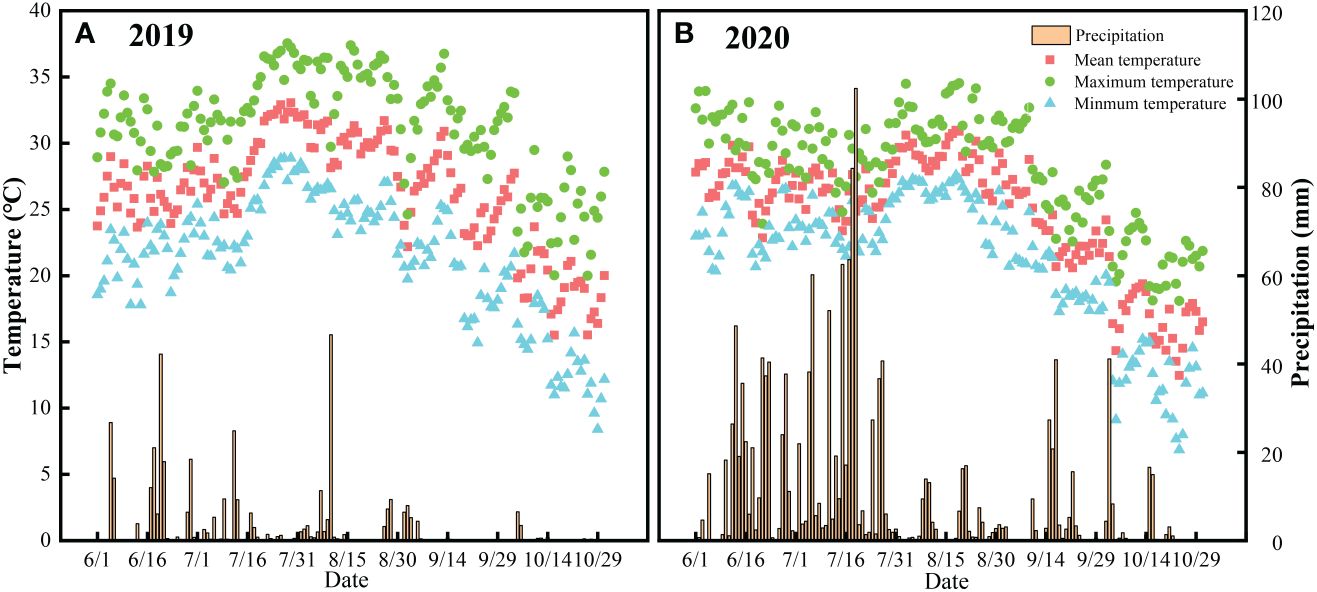
Figure 1 Temperature and precipitation in the rice season in 2019 (A) and 2020 (B), respectively. The yellow bar chart represents daily precipitation, while the triangular, square, and circular point charts represent minimum, mean and maximum temperatures, respectively.
The CRNs (44.5% N) were purchased from Anhui Moith Agricultural Technology Co., Ltd. in China centered on a urea pellet coated with polyurethane. In this study, two N release periods of CRNs were used. Two CRNs with the N release periods of 40 and 90 days are abbreviated as CRN1 and CRN2, respectively. The N release characteristics of CRN1 and CRN2 in 25°C water and paddy fields for 42 and 100 days were measured in the 2019 (Yuan et al., 2023).
A split-plot design was used, with the main plot being the type of N fertilizer and its application method, and the subplot being N application rate. The numbers of main plot and subplot per replicate were 2 and 5, respectively. The plot size was 5 m × 6 m. The main plot treatments were as follows: 1. blended CRN treatment: the conventional N fertilizer, CRN1 and CRN2 with a 4:3:3 ratio of the N rate applied at one-time, and 2. conventional N fertilizer treatment: the conventional N fertilizer applied at three times as basal, tillering and panicle fertilizer. The subplot treatments were N application rates at 0, 60, 120, 180, and 240 kg N ha-1. The 0 rate was the same for both two main plot factors. Therefore, there were 9 treatments in the experiment. The amount and application method of N fertilizer in the different treatment are shown in Table 2. Triple superphosphate and potassium chloride were applied as basal fertilizers at a rate of 39 kg P ha-1 and 62 kg K ha-1, respectively.
The rice variety and timing of the planting and management operations in this study are shown in Table 3. All rice varieties used in this study were high-yield super indica rice, which are commonly grown in the region. The spacing of transplanted rice was 0.30 m (length) by 0.13 m (width).

Table 3 Rice varieties and planting times (month/day) of sowing, transplanting and management operations at three experiment sites.
At the anthesis and maturity, the number of tillers per unit area in each plot was measured. Based on the average number of tillers per hole, rice from three representative holes were selected for destructive sampling. The samples were divided into two parts: leaf and stem, and panicle. The panicle samples at maturity were used to determine the yield components, including the number of panicles (NP), the number of spikelets per panicle (NSP), seed-setting rate (SR), and 1000-grain weight (GW). Thereafter, the samples were dried at 105°C for 30 min and then dried continuously at 85°C for 48 h and weighed. The biomass weight was the sum of dry matter weight of shoots and panicles (Yuan et al., 2021). The dry matter samples were digested with H2SO4-H2O2. The N concentrations in the digests were determined by the Kjeldahl method (Bremner and Mulvaney, 1982).
At the final stage, the entire length of 20 rows of every plot was harvested manually to obtain the seed weight and moisture content. The rice grain yield was determined at 14% moisture content (Yang et al., 2006).
The NUE was calculated according to the following equation (Sun et al., 2012):
Based on the dry matter (DM) and N concentration, the accumulation and translocation parameters of DM and N after anthesis stage were calculated according to the following equations (Ntanos and Koutroubas, 2002; Jiang et al., 2004):
Economic benefit calculation: the output value was calculated according to the average yield and the average price of rice sold in the 2019 and 2020 (2.5 Yuan kg-1). The labor cost of rice fertilization was 900 Yuan ha-1 each time. The fertilizer cost was calculated according to the prices and amount of fertilizer. The average prices of urea, CRN, potassium and phosphorus fertilizer were 2.0, 2.8, 2.0 and 0.6 Yuan kg-1 in 2019 and 2020, respectively. The other rice production costs included seed cost, irrigation cost, and disease, pest and weed management costs, etc, which were the same under all the treatments for two years. Moreover, this study mainly focused on the impact of costs associated with the type and application method of N fertilizer on the economic benefits of rice. Therefore, the net economic benefit this study was a partial net economic benefit due to the fact that the other rice production costs was not calculated.
The net economic benefit was calculated according to the following equation:
Rice yield, NUE, and the accumulation and translocation parameters of dry matter and N after the anthesis stage were analyzed as split-plot analyses of variance (Equation 1), where the type and application method of N fertilizer were assigned as the main plot factor, and the N application rate as the sub-plot factor. The analyses were performed separately for each site and location, and differences in treatment means were assessed using the least significant difference test. Also, the relationships between parameters were analyzed by using the Pearson correlation method. The analyses were conducted with the SPSS 20.0 software (SPSS 22.0, IBM Corp., Armonk, NY, USA), and all analyses were reported as significant at P ≤ 0.05. The figures were created using the Origin 2022 software (OriginLab Corp., Northampton, MA, USA).
Compared to the conventional N fertilizer at the equal N application rate, the blended CRN treatments increased the grain yield by an average of 0.9 - 6.7% at the three experiment sites across the two years (Figures 2A-F, P< 0.05). The rice yield increased significantly with the increase of N application rate (Figures 2A-F, P< 0.01) with no significant interaction of N type × rate (Figures 2A-F). The rice yield in 2020 was, on average, 18.3% lower than that in 2019. The N type had consistent effects on rice yields at the three experiment sites across the two years (Figures 2A-F).
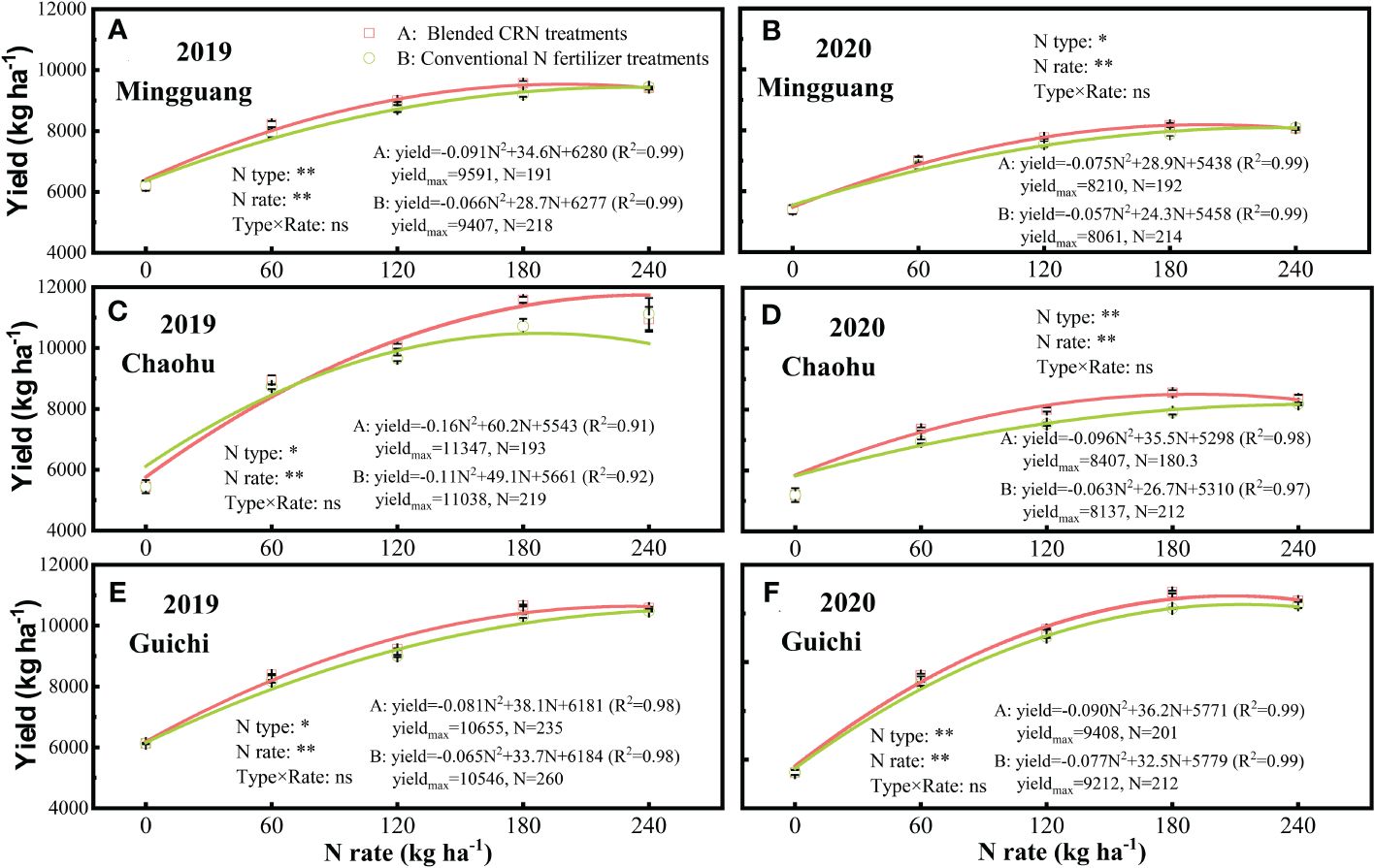
Figure 2 Rice yield under the treatments of blended controlled-release nitrogen fertilizer (CRN) (red square) and conventional N fertilizer treatments (green circle) applied at 0, 60, 120, 180, and 240 kg N ha-1 in 2019 and 2020 at Mingguang (A, B), Chaohu (C, D) and Guichi (E, F) field sites, respectively. Statistically significant differences (P< 0.01**; P< 0.05*) and no significant differences (P > 0.05, ns) are shown. Values are the means ± SE (n=3).
The relationship between rice yield and N fertilizer rate can be simulated by a quadratic equation (Figures 2A-F). Under the blended CRN treatments, the highest average yield was 9604 kg ha-1 at 200 kg N ha-1 (Figures 2A-F). Compared with the conventional N fertilizer treatments, the maximum yield of the blended CRN treatments increased by 109-309 kg ha-1, with an average increase of 1.6%, and the corresponding N application rate decreasing by 10-32 kg ha-1, with an average decrease of 14.7% (Figures 2A-F).
Compared with the conventional N fertilizer, the blended CRN application significantly increased the number of spikelets per panicle and seed-setting rate by averages of 1.6% and 2.0%, respectively. In contrast, the blended CRN application decreased the number of panicles by 2.0% (Table 4, P< 0.05). Increasing N application rate significantly increased these two parameters (Table 4, P< 0.01). The N type had consistent effects on rice components across the three experiment sites and two years (Table 4).
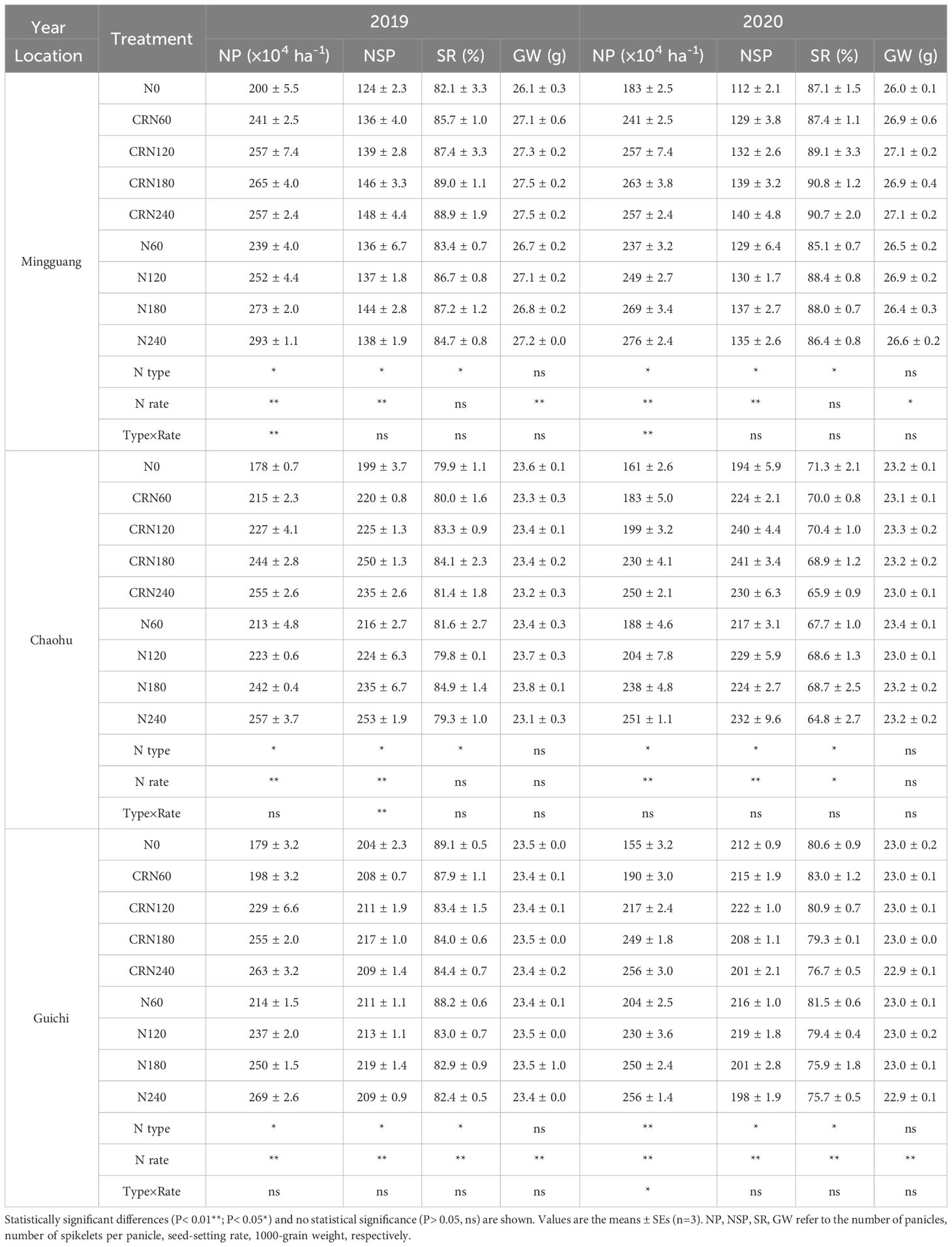
Table 4 The yield components of rice grown at Mingguang, Chaohu and Guichi field sites under the treatments of blended controlled-release nitrogen fertilizer (CRN) and conventional N fertilizer (N) applied at 0, 60, 120, 180, and 240 kg N ha-1 in 2019 and 2020.
With the equal N application rate, NUE was significantly higher under the blended CNR than the conventional N fertilizer treatments (Figures 3A-F, P< 0.05). The increases were 5.0-16.2%, 3.2-28.4%, 10.4-21.8%, and 4.7-18.7% at 60, 120, 180 and 240 kg N ha-1, respectively. Increasing N application rate decreased NUE (Figures 3A-F, P< 0.01). There was no interaction between N type and rate on NUE (Figures 3A-F). The treatment effects on NUE followed similar trend at the three experiment sites over the two years (Figures 3A-F). According to the quadratic equation, the blended CNR treatments had 31.9% higher than the conventional N fertilizer treatments at the highest average grain yield.
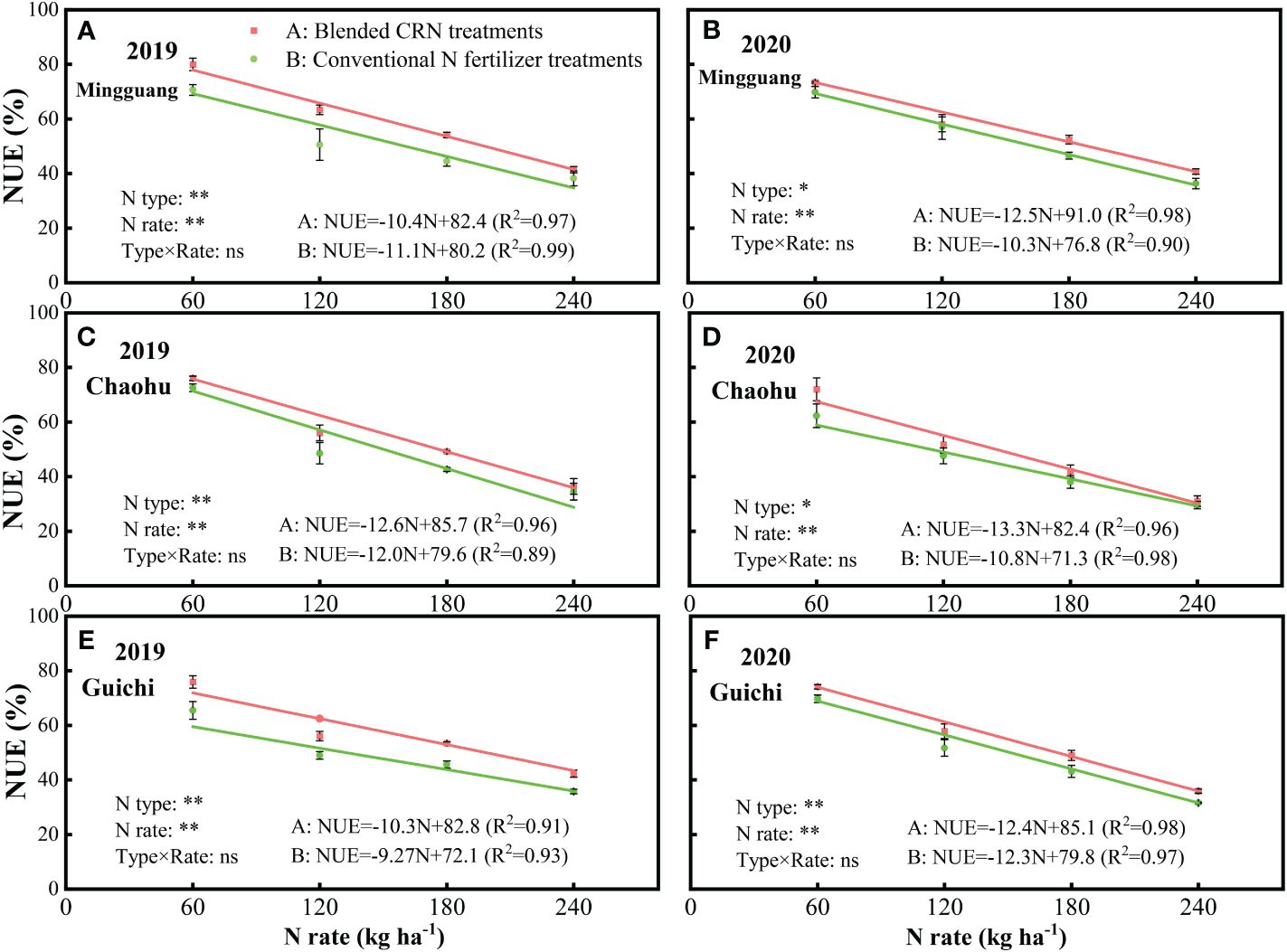
Figure 3 The N-use efficiency (NUE) under the treatments of blended controlled-release nitrogen fertilizer (CRN) (red) and conventional N fertilizer (green) applied at 0, 60, 120, 180, and 240 kg N ha-1 in 2019 and 2020 at Mingguang (A, B), Chaohu (C, D) and Guichi (E, F) field sites, respective.
Compared with the conventional N fertilizer, the use of blended CRN (Equation 2) significantly increased pre-anthesis DM translocation (Equation 3) (Pre-DMT), pre-anthesis N translocation efficiency (Equation 4) (Pre-DMTE), and the contribution of Pre-DMT to grain yield (Pre-DMC) by 0.8-36.7%, 0.4-25.3%, and 0.7-37.0%, respectively, but decreased the contribution (Equation 5) of pre-anthesis DM accumulation to grain yield (Post-DMC) by 0.3-25.9% (Supplementary Table S1; Table 5, P<0.05). Increasing N dose significantly increased Pre-DMT, Post-DMA, Pre-DMTE and Pre-DMC (Supplementary Table S1, P<0.05), but decreased Post-DMC at Chaohu and Guichi experiment sites (Supplementary Table S1; Table 5, P< 0.05).
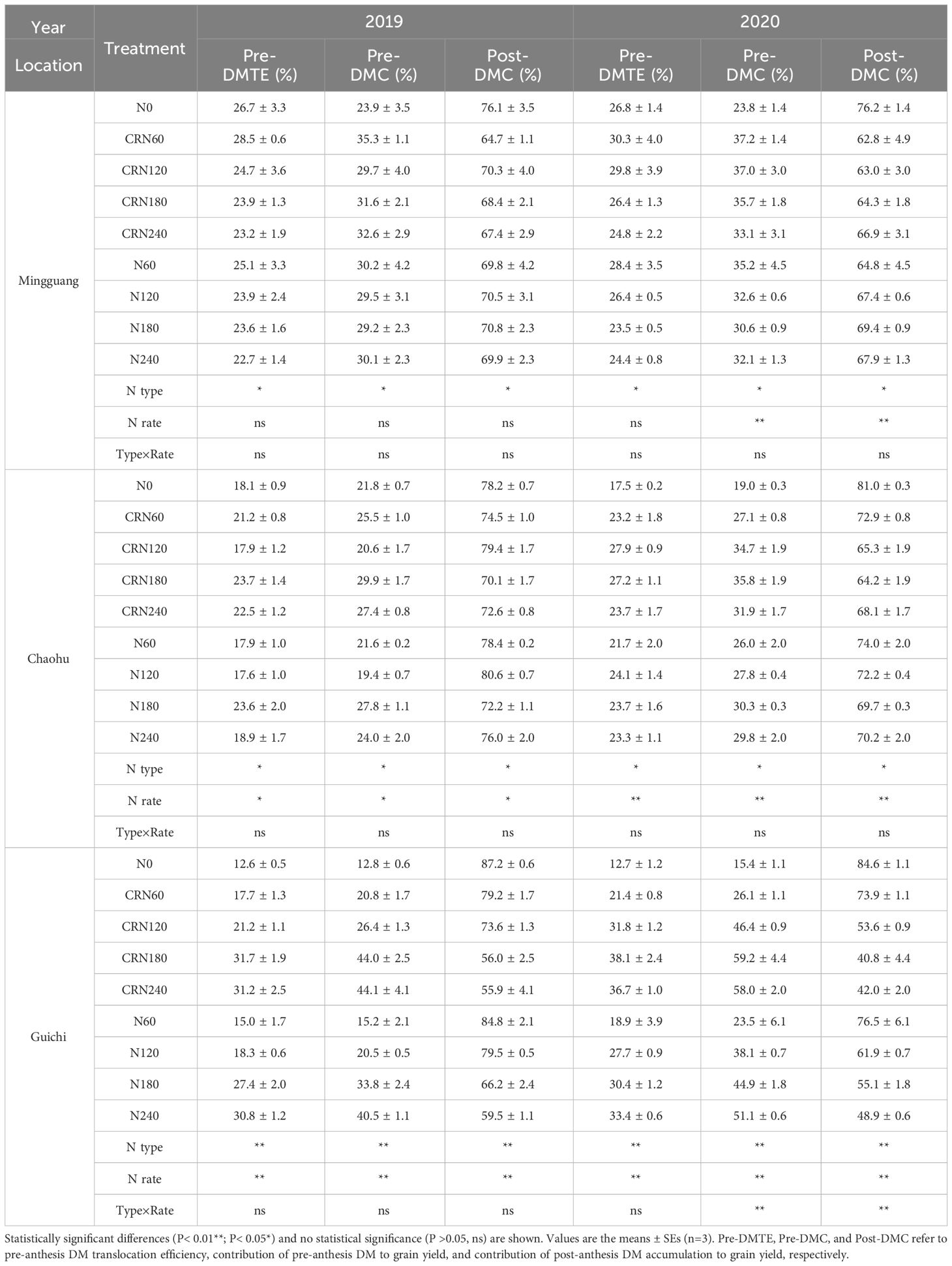
Table 5 Pre-anthesis and post-anthesis dry matter (DM) accumulation and translocation of rice plants grown in the treatments of blended controlled-release nitrogen fertilizer (CRN) and conventional N fertilizer applied at 0, 60, 120, 180, and 240 kg N ha-1 in 2019 and 2020.
Compared with the conventional N fertilizer (Equation 6), the blended CRN increased the pre-anthesis N translocation (Pre-NT) and the contribution of pre-NT to grain N (Equation 9) (Pre-NC) by 1.0-19.8% and 0.2-8.7%, respectively, while decreased the contribution of post-anthesis N translocation to grain N (Equation 7) (Post-NC) by 1.0-24.8% (Supplementary Tables S2; Table 6, P< 0.05). The fertilizer (Equation 8) type did not affect the pre-anthesis N translocation efficiency (Pre-NTE) (Table 6, P > 0.05). Increasing N rate significantly increased the Pre-NT, post-anthesis N uptake (Post-NU), and Post-NC, but decreased Pre-NTE and the contribution of pre-NT to grain N (Pre-NC) by 0.1-23.6% and 0.1-20.0%, respectively (Supplementary Table S2; Table 6, P< 0.05). The effects of N type and dose on N accumulation and translocation were consistent across the three experiment sites over two years (Table 6).
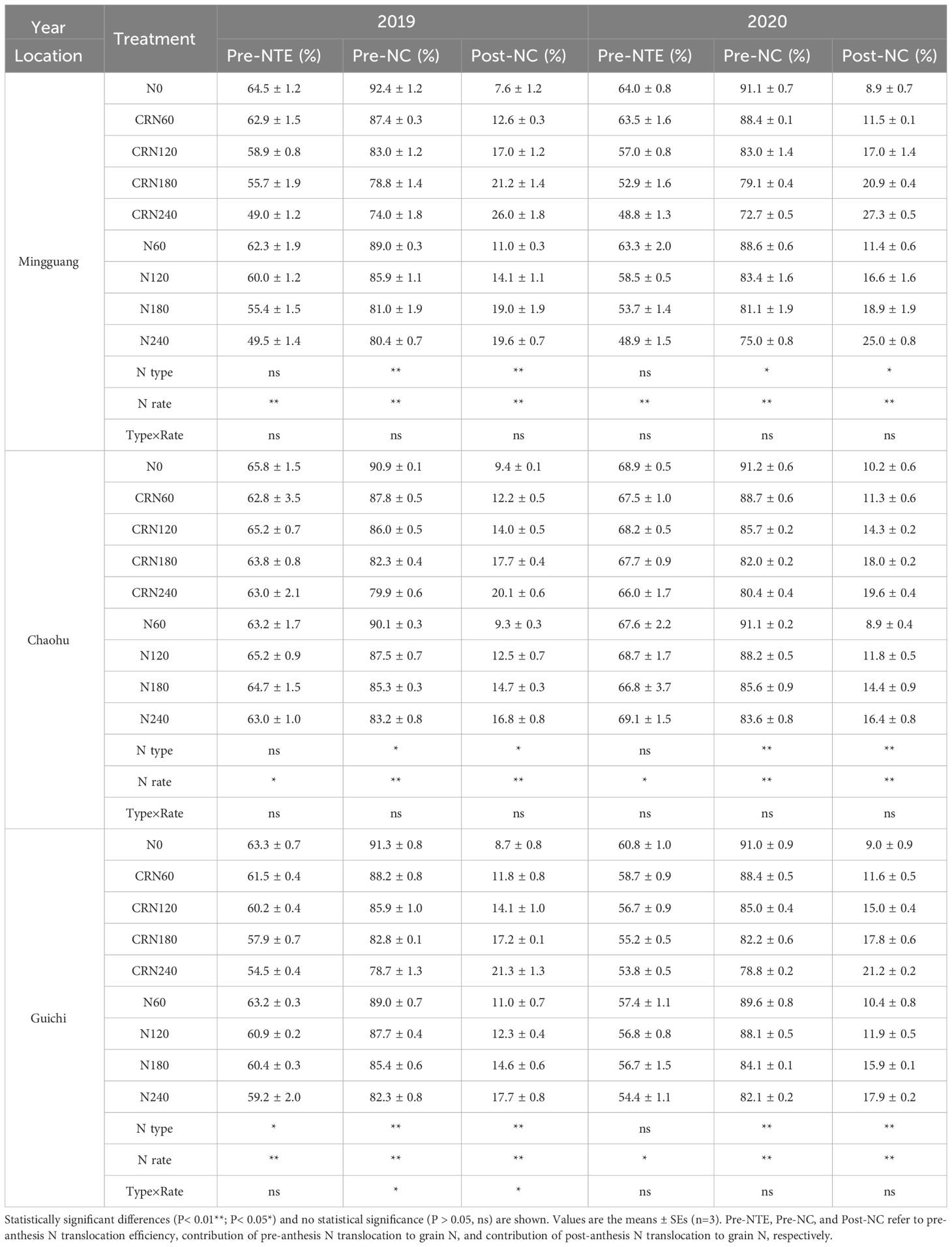
Table 6 Pre-anthesis and post-anthesis N accumulation and translocation of rice plants grown in the treatments of blended controlled-release nitrogen fertilizer (CRN) and conventional N fertilizer applied at 0, 60, 120, 180, and 240 kg N ha-1 in 2019 and 2020.
Dry matter and N accumulation, translocation, and utilization are closely related to yield and NUE. Rice yield was correlated positively with NP, NSP, Pre-DMT, Pre-DMC, Pre-NT, Post-NU, Post-NC but negatively with Pre-DMTE, Post-DMC, Pre-NTE, Pre-NC and NUE (Table 7, P<0.05). The NUE was correlated positively with Post-DMC and Pre-NC, but negatively with yield, NP, Pre-DMT, Pre-DMC, Post-NU and Post-NC (Table 7, P<0.05).
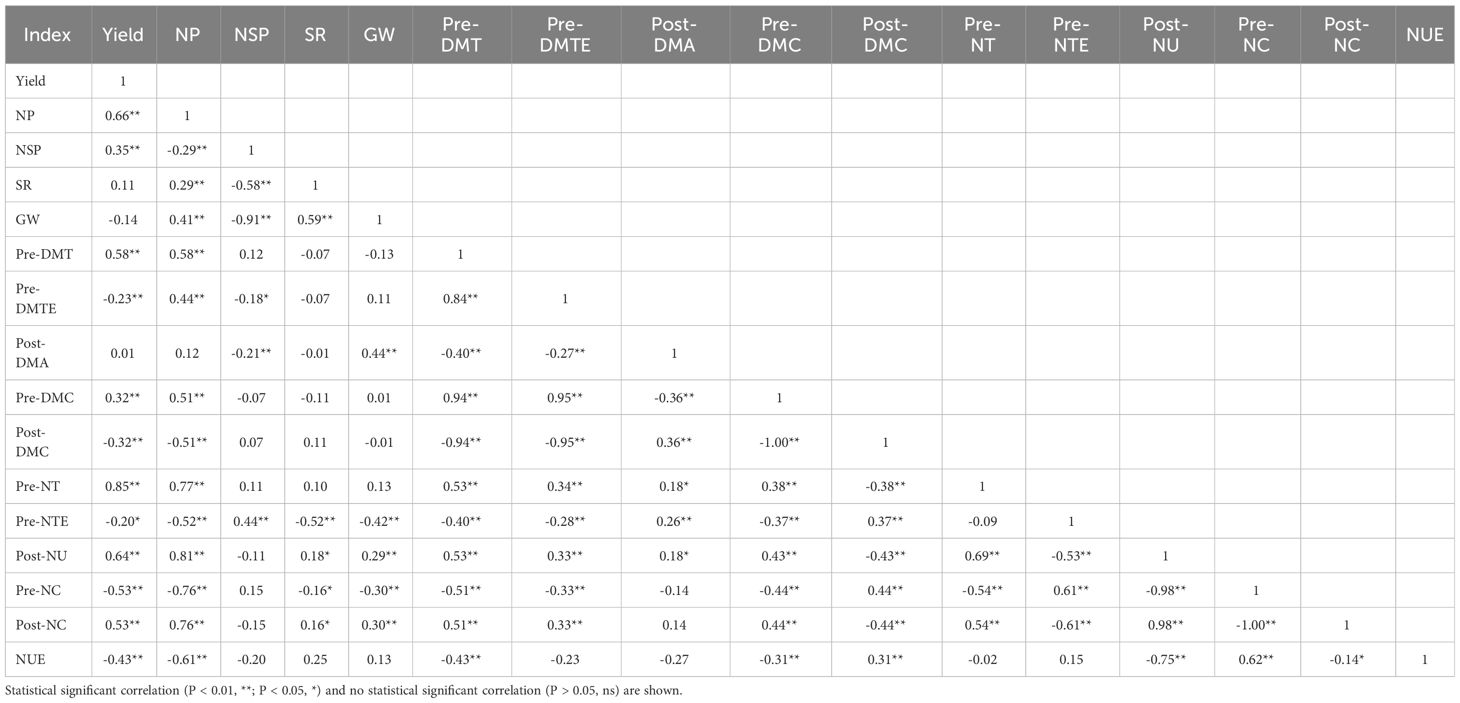
Table 7 Pearson corrections among yield, the number of panicles (NP), number of spikelets per panicle (NSP), seed-setting rate (SR), 1000-grain weight (GW), pre-anthesis dry matter (DM) translocation (Pre-DMT), pre-anthesis DM translocation efficiency (Pre-DMTE), post-anthesis DM accumulation (Post-MDA), contribution of pre-DMT (Pre-MDC), contribution of post-DMA (Post-MDC), pre-anthesis N translocation(Pre-NT), pre-anthesis N translocation efficiency (Pre-NTE), post-anthesis N uptake (Post-NU), contribution of pre-NT to grain N (Pre-NC) and contribution of post-NU to grain N (Post-NC) and N-use efficiency (NUE) of rice plants grown under various treatments in the 2019 and 2020 seasons (n=162).
The effects of N type and application rate on economic benefits were assessed by average yields across three sites over two years (Table 8). The N fertilization increased fertilizer cost, economic output and net economic benefit increased by 38.5-179.0%, 33.5-67.5% and 21.5-68.8%, respectively (Equation 10). Compared with the conventional N fertilization, the blended CRN treatments reduced the labor cost by 1800 Yuan ha-1, but increased the fertilizer cost, economic output and net economic benefit by 4.5-9.8%, 0.2-5.2% and 8.8-15.3%, respectively. Using quadratic equation simulation, the highest net benefit was 21450 Yuan ha-1 under the blended CNR at an application rate of 189 kg ha-1 and NUE of 47.3%. In comparison, the highest net economic benefit was 19161 Yuan ha-1 under the conventional N fertilization at an application rate of 247 kg ha-1 and NUE of 31.9%. The blended CNR treatment had 11.9% higher net profit, but the applied N rate was 23.6% lower N dose and NUE was 50.4% higher NUE than the conventional N fertilization.
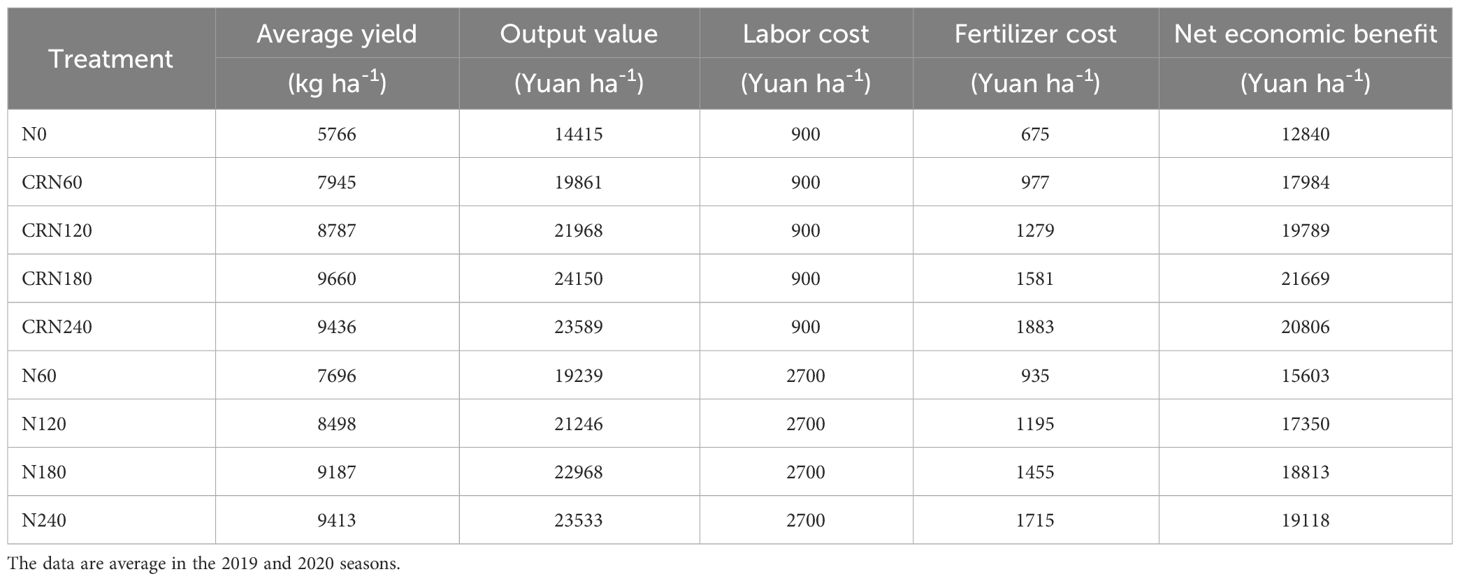
Table 8 The output values, labor and costs, and net economic benefits under the treatments of blended controlled-release nitrogen fertilizer (CRN) and conventional N fertilizer applied at 0, 60, 120, 180, and 240 kg N ha-1.
The final yield of rice results from the translocation of pre-anthesis stored DM and post-anthesis accumulation of photosynthetic products (Kumar et al., 2006). Appropriate N fertilizer type, rate and management can improve the photosynthetic rate and increase biomass and N accumulation and translocation, and hence yield (Artacho et al., 2009; Wang et al., 2018; Ju et al., 2021). The blended CRN treatment increased pre-anthesis DM translocation (Pre-DMT) and the contribution of Pre-DMT to grain yield (Pre-DMC) compared with the conventional N fertilizer treatment (Supplementary Tables S1, Table 5, P<0.05), which was consistent with the results of Wang et al. (2018). In addition, rice yield was positively correlated with Pre-DMT and Pre-DMC (Table 7, P<0.01), in agreement with the findings by Pal et al. (2017). This may be related to the fact that the blended CRN treatment decreased ineffective tillering to increase panicle number (Table 4), improved post-anthesis root function, especially cytokinin transport to leaves, and increased the accumulation of photosynthetic assimilates (Gu et al., 2017). The blended CRN might play a role in enhancing the sink and source sizes.
Rice yield also depends on yield components, including the number of panicles (NP), the number of spikelets per panicle (NSP), seed-setting rate (SR), and 1000-grain weight (GW). Previous studies have shown that one-time application of CRN increased NP, NSP, and SR of rice, thereby increasing yield (Guang et al., 2018; Wang et al., 2018). In this study, compared with the conventional urea use, one-time application of CRN significantly improved rice yield, mainly due to the increased NSP (Table 4). The positive correlation between NSP and yield in this study (Table 5) was consistent with previous studies (Artacho et al., 2009; Lan et al., 2021). Although the blended CRN treatment of significantly reduced the NP (Table 4), the contribution of the NP and NSP to rice yield is a trade-off process (Sui et al., 2013). Due to its slow N release at the tillering stage (Yuan et al., 2023), CRN decreased the NP of rice by 3.8-11.7% and increased the NSP by 11.8-21.8% during the heading stage compared to the common urea (Dun et al., 2023). Moreover, the lack of a significant N type effect on GW in this study (Table 4; P>0.05) was consistent with previous reports (Sui et al., 2013; Wang et al., 2018), suggesting that the GW is a stable trait determined by rice genotype.
Nitrogen fertilization is an important measure to promote sustainable crop production (Li et al., 2017). There is not a simple linear relationship between N application rate and rice yield but the one-variable quadratic can describe this relationship well (Ju et al., 2021). According to the quadratic equation, the optimal N application rate differed slightly for different rice varieties under the conventional N fertilization. The optimal N application rates for the highest yields of rice varieties HD-5 and YJ-8 under the conventional N fertilizer treatment were 255 and 261 kg ha-1, respectively (Ju et al., 2021). Under the blended CRN treatment, this study obtained the average optimal N application rate of 200 kg ha-1, which was lower than previous results. Wang et al. (2018) recommended the N application rate of 150 kg ha-1 for rice crop in the Yangtze River Basin of China to achieve a rice yield of approximately 7700 kg ha-1. This yield was comparable to the rice yield of 7820 kg ha-1 at the N application rate of 60 kg ha-1 in our study, with the yield further increasing with increasing N dose to 120 and 180 kg ha-1 (8540 and 9420 kg ha-1, respectively). The reason for such a discrepancy in yield response to N fertilization was related to the different rice varieties. Wang et al. (2018) tested indica varieties of rice, while this study used super hybrid rice varieties. At the equivalent N application rate, the yield of super hybrid rice was higher than that of indica rice (Hu et al., 2020; Zhu et al., 2020). Therefore, rice varieties and their yield potential should be considered when the N fertilizer program is formulated.
Intensive agricultural production in developing countries faces the dual challenge of ensuring sustained increases in crop yields and reducing the environmental risks of excessive fertilizer inputs (Chen et al., 2011). Changing N application methods, such as deep application and split application, or fertilizer type, has achieved simultaneous improvement in rice yield and NUE, mainly through reducing N losses such as NH3 volatilization, N runoff and NO3 leaching (Huang et al., 2019; Liu et al., 2016; Wang et al., 2018; Yuan et al., 2023). This and previous studies demonstrated that the single application of CRN improved NUE compared with the urea split application (Wang et al., 2018; Huang et al., 2019). This improved NUE was mainly due to the slow N release and longevity (40 and 90 d) of CRNs in the paddy fields.
The NUE is closely related to grain N accumulation, which could be derived via translocation of the pre-anthesis stored N and the post-anthesis uptake of soil N (Jiang et al., 2005; Wei et al., 2017). In this study, Pre-NC under the blended CRN treatment was 74.0-88.7% which was significantly higher than that under the conventional N fertilizer treatment (Table 6). The results implied that the blended CRN treatment was more conducive than the conventional N fertilizer treatment to enhancing the re-translocation of N from stems and leaves to grains. The increased yield and NUE under blended CRN fertilization had resulted from the increased Pre-NT (Table 6), improved photosynthetic rate, delayed leaf senescence, and increased post-anthesis carbon assimilation (Wu et al., 2018).
Economic benefit is one of the important factors influencing farmers to adopt fertilizer management practices (Zhang et al., 2021). The relatively high price of CRNs limits their use in farming practices such as rice production (Naz and Sulaiman, 2016). However, this study suggested that the blended CRN treatments could improve the economic benefits for rice cultivation (Table 8). With accelerated urbanization, labor for agricultural cultivation has become expensive (Chen et al., 2014). Compared with the conventional N fertilization, the use of blended CRN could save labor costs. Under the blended CRN treatment, labor cost saving offset the increased fertilizer cost, which ultimately increased the profitability for the rice growers (Table 8). It appears to be an effective way to achieve high grain yield and NUE by optimizing the N management mode of CRN and urea blended application (Guo et al., 2019; Huang et al., 2019; Zhang et al., 2021).
At the equivalent N rate, the rice yield, NUE and economic benefit significantly increased under the blended CRN treatment. The quadratic equation estimated that the N rate for the highest yield under the blended CRN treatment was 200 kg ha-1 and NUE was 45.9%, which were 14.7% less and 31.9% more than those under the conventional N fertilizer treatment, respectively. The rice yield at the highest economic benefit was slightly below the highest yield. At the highest economic benefit under the blended CRN treatment, the N rate was 189 kg ha-1 and NUE was 47.3%, which were 23.6% less and 50.4% more than those under the conventional N fertilizer treatment, respectively. The increase in NUE was due to the increase in Pre-NT and Post-NC under the blended CRN fertilizer treatment. The increase in economic benefit was mainly due to the reduction in labor cost under the blended CRN fertilizer treatment. The application rate of the blended CRN at 189 kg N ha-1 is recommended for rice production in the Yangtze River Delta.
The original contributions presented in the study are included in the article/Supplementary Material. Further inquiries can be directed to the corresponding authors.
MY: Data curation, Formal analysis, Investigation, Writing – original draft, Writing – review & editing, Conceptualization. GW: Formal analysis, Investigation, Writing – review & editing, Supervision. JW: Investigation, Writing – review & editing, Methodology, Project administration. CL: Software, Writing – review & editing, Formal analysis. YH: Resources, Writing – review & editing. RH: Resources, Writing – review & editing. YZ: Resources, Writing – review & editing. XZ: Investigation, Writing – review & editing. WW: Investigation, Writing – review & editing. YS: Conceptualization, Funding acquisition, Project administration, Writing – review & editing.
The author(s) declare financial support was received for the research, authorship, and/or publication of this article. The National Key Research & Development Program of China (No. 2023YFD1901102, No. 2022YFD2301403, No.2016YFD0200806), the Key Research & Development Program of Anhui Province (2023n06020019) and the Natural Science Foundation of Anhui Province (2108085QC124).
Many thanks go to Dr Caixian Tang of La Trobe University, Dr Jianguo Zhu, Dr Zubin Xie, Dr Chuang Cai of Institute of Soil Science, Chinese Academy of Sciences, Dr Xiaozhong Wang of Academy of Agricultural Sciences, Southwest University for revising the manuscript.
The authors declare that the research was conducted in the absence of any commercial or financial relationships that could be construed as a potential conflict of interest.
All claims expressed in this article are solely those of the authors and do not necessarily represent those of their affiliated organizations, or those of the publisher, the editors and the reviewers. Any product that may be evaluated in this article, or claim that may be made by its manufacturer, is not guaranteed or endorsed by the publisher.
The Supplementary Material for this article can be found online at: https://www.frontiersin.org/articles/10.3389/fpls.2024.1354384/full#supplementary-material
Supplementary Table 1 | Pre-anthesis dry matter translocation (Pre-DMT) and post-anthesis dry matter accumulation (Post-DMA) of rice crop grown in the treatments of blended controlled-release nitrogen fertilizer (CRN) and conventional N fertilizer applied at 0, 60, 120, 180, and 240 kg N ha-1 in 2019 and 2020. Statistically significant differences (P< 0.01, **; P< 0.05, *) and no statistical significance (P > 0.05, ns) are shown. Values are the means ± SEs (n=3).
Supplementary Table 2 | Pre-anthesis N translocation (Pre-NT) and post-anthesis N uptake (Post-NU) of rice grown in the treatments of blended controlled-release nitrogen fertilizer (CRN) and conventional N fertilizer applied at 0, 60, 120, 180, and 240 kg N ha-1 in 2019 and 2020. Statistically significant differences (P< 0.01, **; P< 0.05, *) and no statistical significance (P > 0.05, ns) are shown. Values are the means ± SEs (n=3).
Artacho, P., Bonomelli, C., Meza, F. (2009). Nitrogen application in irrigated rice grown in Mediterranean conditions: effects on grain yield, dry matter production, nitrogen uptake, and nitrogen use efficiency. J. Plant Nutr. 32, 157–1593. doi: 10.1080/01904160903094339
Bremner, J. M., Mulvaney, C. S. (1982). “Total nitrogen,” in Methods of soil science society of america journal, vol. 328 . Eds. Page, T., Miller, J. M., Keeney, D. R.(Madison, WI, USA: American Society of Agronomy), 595–642.
Chen, X., Cui, Z., Fan, M., Vitousek, P., Zhao, M., Ma, W., et al. (2014). Producing more grain with lower environmental costs. Nature 514, 486. doi: 10.1038/nature13609
Chen, X. P., Cui, Z. L., Vitousek, P. M., Cassman, K. G., Matson, P. A., Bai, J. S., et al. (2011). Integrated soil-crop system management for food security. Proc. Natl. Acad. Sci. United States America 108, 6399–6404.
Chen, Z., Wang, Q., Ma, J., Zou, P., Jiang, L. (2020). Impact of controlled-release urea on rice yield, nitrogen use efficiency and soil fertility in a single rice cropping system. Sci. Rep. 10, 10432. doi: 10.1038/s41598-020-67110-6
Cheng, J., Jiang, H., Pan, X., Dai, T., Cao, W. (2010). Effects of nitrogen rates on Post-anthesis accumulation and transfer of dry matter and nitrogen in rice with differential nitrogen nutrition efficiency. Chin. Agric. Sci. Bull. 26, 150–156.
Congreves, K. A., Otchere, O., Ferland, D., Farzadfar, S., Williams, S., Arcand, M. M. (2021). Nitrogen use efficiency definitions of today and tomorrow. Fronts Plant Sci. 12, 912. doi: 10.3389/fpls.2021.637108
Deng, F., Wang, L., Ren, W. J., Mei, X. F., Li, S. X. (2015). Optimized nitrogen managements and polyaspartic acid urea improved dry matter production and yield of indica hybrid rice. Soil Tillage Res. 145, 1–9. doi: 10.1016/j.still.2014.08.004
Dun, C. P., Wang, R., Mi, K. L., Zhang, Y. T., Zhang, H. P., Cui, P. Y., et al. (2023). One-time application of controlled-release bulk blending fertilizer enhanced yield quality and photosynthetic efficiency of late japonica rice. J. Integr. Agric. doi: 10.1016/j.jia.2023.10.007
Gu, J. F., Chen, Y., Zhang, H., Li, Z., Yang, J. (2017). Canopy light and nitrogen distributions are related to grain yield and nitrogen use efficiency in rice. Field Crops Res. 206, 74–85. doi: 10.1016/j.fcr.2017.02.021
Guang, C., Tingting, C., Song, C., Chunmei, X., Xiufu, Z., Danying, W. (2018). Polymer-coated urea application could produce more grain yield in "super" rice. Agron. J. 110, 246–259. doi: 10.2134/agronj2017.07.0400
Guo, J., Wang, Y., Blaylock, A. D., Chen, X. (2019). Mixture of controlled release and normal urea to optimize nitrogen management for high-yielding (& 15 Mg ha-1) maize. Field Crops Res. 204, 23–30.
Hu, J., Wang, D., Liu, K., Chu, G., Huang, L., Tian, X., et al. (2020). Inbred varieties outperformed hybrid rice varieties under dense planting with reducing nitrogen. Sci. Rep. 10, 8769. doi: 10.1038/s41598-020-65574-0
Huang, Q., Fan, X., Tang, S., Zhang, M., Huang, X., Yi, Q., et al. (2019). Seasonal differences in N release dynamic of controlled-released urea in paddy field and its impact on the growth of rice under double rice cropping system. Soil Tillage Res. 195, 104371. doi: 10.1016/j.still.2019.104371
IFA. (2021). IFADATA statstics. Paris: International Fertilizer Industry Association. http://www.fertilizer.org/ifa/HomePage/STATISTICS[EB/OL].
Jiang, L. G., Dai, T. B., Jiang, D., Cao, W. X., Gan, X. Q., Wei, S. (2004). Characterizing physiological N-use efficiency as influenced by nitrogen management in three rice cultivars. Field Crops Res. 88, 239–250. doi: 10.1016/j.fcr.2004.01.023
Jiang, L. G., Dong, D. F., Gan, X. Q., Wei, S. Q. (2005). Photosynthetic efficiency and nitrogen distribution under different nitrogen management and relationship with physiological N-use efficiency in three rice genotypes. Plant Soil 271, 321–328. doi: 10.1007/s11104-004-3116-9
Ju, C., Zhu, Y., Liu, T., Sun, C. (2021). The effect of nitrogen reduction at different stages grain yield and nitrogen use efficiency for nitrogen efficient rice varieties. Agronomy 11, 462. doi: 10.3390/agronomy11030462
Kumar, R., Sarawgi, A. K., Ramos, C., Amarante, S. T., Ismail, A. M., Wade, L. J. (2006). Partitioning of dry matter during drought stress in rainfed lowland rice. Field Crops Res. 96, 455–465. doi: 10.1016/j.fcr.2005.09.001
Lan, Y., Sui, X., Wang, J., Duan, Q., Wu, C., Ding, C., et al. (2021). Effects of nitrogen application rate on protein components and yield of low gluten rice. Agriculture 11, 302. doi: 10.3390/agriculture11040302
Lassaletta, L., Billen, G., Grizzetti, B., Anglade, J., Garnier, J. (2014). 50 year trends in nitrogen use efficiency of world cropping systems: the relationship between yield and nitrogen input to cropland. Environ. Res. Lett. 9, 105011. doi: 10.1088/1748-9326/9/10/105011
Li, H., Hu, B., Chu, C. (2017). Nitrogen use efficiency in crops: Lessons from Arabidopsis and rice. J. Exp. Bot. 68, 2477–2488. doi: 10.1093/jxb/erx101
Liu, Y., Gao, F., Yi, H., Yang, C., Zhang, R., Zhou, Y., et al. (2021). Recent advances in selective catalytic oxidation of nitric oxide (NO-SCO) in emissions with excess oxygen: a review on catalysts and mechanisms. Environ. Sci. Pollut. R. 28, 2549–2571.
Lyu, Y., Yang, X., Pan, H., Zhang, X., Cao, H., Ulgiati, S., et al. (2021). Impact of fertilization schemes with different ratios of urea to controlled release nitrogen fertilizer on environmental sustainability, nitrogen use efficiency and economic benefit of rice production: A study case from Southwest China. J. Clean. Product. 293, 126198. doi: 10.1016/j.jclepro.2021.126198
Mae, T. (1997). Physiological nitrogen efficiency in rice: Nitrogen utilization, photosynthesis, and yield potential. Plant Soil 196, 201–210. doi: 10.1023/A:1004293706242
Mae, T., Ohira, K. (1981). The remobilization of nitrogen related to leaf growth and senescence in rice plants (Oryza sativa L.). Plant Cell Physiol. 22, 1067–1074.
Naz, M. Y., Sulaiman, S. A. (2016). Slow release coating remedy for nitrogen loss from conventional urea: a review. J. Controlled Release 225, 109–120. doi: 10.1016/j.jconrel.2016.01.037
Ntanos, D. A., Koutroubas, S. D. (2002). Dry matter and N accumulation and translocation for Indica and Japonica rice under Mediterranean conditions. Field Crops Res. 74, 93–101. doi: 10.1016/S0378-4290(01)00203-9
Pal, R., Mahajan, G., Sardana, V., Chauhan, B. S. (2017). Impact of sowing date yield, dry matter and nitrogen accumulation, and nitrogen translocation in dry-seeded rice in North-West India. Field Crops Res. 206, 138–148. doi: 10.1016/j.fcr.2017.01.025
Sui, B., Feng, X., Tian, G., Hu, X., Shen, Q., Guo, S. (2013). Optimizing nitrogen supply increases rice yield and nitrogen use efficiency by regulating yield formation factors. Field Crops Res. 150, 99–107. doi: 10.1016/j.fcr.2013.06.012
Sun, Y., Ma, J., Sun, Y., Hui, X., Yang, Z., Liu, S., et al. (2012). The effects of different water and nitrogen managements on yield and nitrogen use efficiency in hybrid rice of China. Field Crops Res. 127, 85–98. doi: 10.1016/j.fcr.2011.11.015
Wang, L., Xue, C., Pan, X., Chen, F., Liu, Y. (2018). Application of controlled-release urea enhances grain yield and nitrogen use efficiency in irrigated rice in the Yangtze river basin, China. Front. Plant Sci. 9, 1–13. doi: 10.3389/fpls.2018.00999
Wei, H. H., Meng, T. Y., Li, C., Xu, K., Huo, Z. Y., Wei, H. Y., et al. (2017). Comparisons of grain yield and nutrient accumulation and translocation in high-yielding japonica/indica hybrids, indica hybrids, and japonica conventional varieties. Field Crops Res. 204, 101–109. doi: 10.1016/j.fcr.2017.01.001
Wu, H., Xiang, J., Zhang, Y., Zhang, Y., Peng, S., Chen, H., et al. (2018). Effects of post-anthesis nitrogen uptake and translocation on photosynthetic production and rice yield. Sci. Rep. 8, 12891. doi: 10.1038/s41598-018-31267-y
Yamaji, N., Takemoto, Y., Miyaji, T., Mitani-Ueno, N., Yoshida, K. T., Ma, J. F. (2017). Reducing phosphorous accumulation in rice grains with an impaired transporter in the node. Nature 541, 92–99. doi: 10.1038/nature20610
Yang, L., Huang, J., Yang, H., Dong, G., Liu, G., Zhu, J., et al. (2006). Seasonal changes in the effects of free-air CO2 enrichment (FACE) on dry matter production and distribution of rice (Oryza sativa L.). Field Crops Res. 98, 12–19. doi: 10.1016/j.fcr.2005.11.003
Yu, F., Shi, W. M. (2015). Nitrogen use efficiencies of major grain crops in China in recent 10 years. Acta Pedologica Sinica. 52, 1311–1324. doi: 10.11766/trxb201501270058
Yu, X., Keitel, C., Zhang, Y., Wangeci, A. N., Dijkstra, F. A. (2022). Global meta-analysis of nitrogen fertilizer use efficiency in rice, wheat and maize. Agricult. Ecosyst. Environ. 338, 108089. doi: 10.1016/j.agee.2022.108089
Yuan, M., Cai, C., Wang, X., Li, G., Wu, G., Wang, J., et al. (2021). Warm air temperatures increase photosynthetic acclimation to elevated CO2 concentrations in rice under field conditions. Field Crops Res. 262, 108036. doi: 10.1016/j.fcr.2020.108036
Yuan, M., Sun, Y., Wu, G., Wang, J., Liu, C., Tang, T., et al. (2023). The optimum economic nitrogen rate of blended controlled-release nitrogen fertilizer or rice in the Chaohu watershed in the Yangtze River Delta, China. Front. Plant Sci. 14, 1144461. doi: 10.3389/fpls.2023.1144461
Zhang, L., Liang, Z., Hu, Y., Schmidhalter, U., Chen, X. (2021). Integrated assessment of agronomic, environmental and ecosystem economic benefits of blending use of controlled-release and common urea in wheat production. J. Clean. Product. 287, 125572. doi: 10.1016/j.jclepro.2020.125572
Zhang, D., Wang, H., Pan, J., Luo, J., Liu, J., Gu, B., et al. (2018a). Nitrogen application rates need to be reduced for half of the rice paddy field in China. Agricult. Ecosyst. Environ. 265, 8–14. doi: 10.1016/j.agee.2018.05.023
Zhang, M., Yao, Y. L., Tian, Y. H., Ceng, K., Zhao, M., Zhao, M., et al. (2018b). Increasing yield and N use efficiency with organic fertilizer in Chinese intensive rice cropping systems. Field Crops Res. 227, 102–109. doi: 10.1016/j.fcr.2018.08.010
Zheng, Y., Han, X., Li, Y., Liu, S., Ji, J., Tong, Y. (2020). Effects on mixed controlled release nitrogen fertilizer with rice straw biochar on rice yield and nitrogen balance in Northeast China. Sci. Rep. 10, 9452. doi: 10.1038/s41598-020-66300-6
Keywords: economic return, yield, nitrogen translocation, post-anthesis nitrogen uptake, urea N type
Citation: Yuan M, Wu G, Wang J, Liu C, Hu Y, Hu R, Zhou Y, Zhang X, Wang W and Sun Y (2024) Blended controlled-release nitrogen fertilizer increases rice post-anthesis nitrogen accumulation, translocation and nitrogen-use efficiency. Front. Plant Sci. 15:1354384. doi: 10.3389/fpls.2024.1354384
Received: 12 December 2023; Accepted: 03 April 2024;
Published: 29 April 2024.
Edited by:
Henry Yabbey Sintim, The University of Georgia, Tifton, United StatesReviewed by:
Depeng Wang, Linyi University, ChinaCopyright © 2024 Yuan, Wu, Wang, Liu, Hu, Hu, Zhou, Zhang, Wang and Sun. This is an open-access article distributed under the terms of the Creative Commons Attribution License (CC BY). The use, distribution or reproduction in other forums is permitted, provided the original author(s) and the copyright owner(s) are credited and that the original publication in this journal is cited, in accordance with accepted academic practice. No use, distribution or reproduction is permitted which does not comply with these terms.
*Correspondence: Yixiang Sun, c3VueWl4aWFuZ0BhYWFzLm9yZy5jbg==
Disclaimer: All claims expressed in this article are solely those of the authors and do not necessarily represent those of their affiliated organizations, or those of the publisher, the editors and the reviewers. Any product that may be evaluated in this article or claim that may be made by its manufacturer is not guaranteed or endorsed by the publisher.
Research integrity at Frontiers

Learn more about the work of our research integrity team to safeguard the quality of each article we publish.